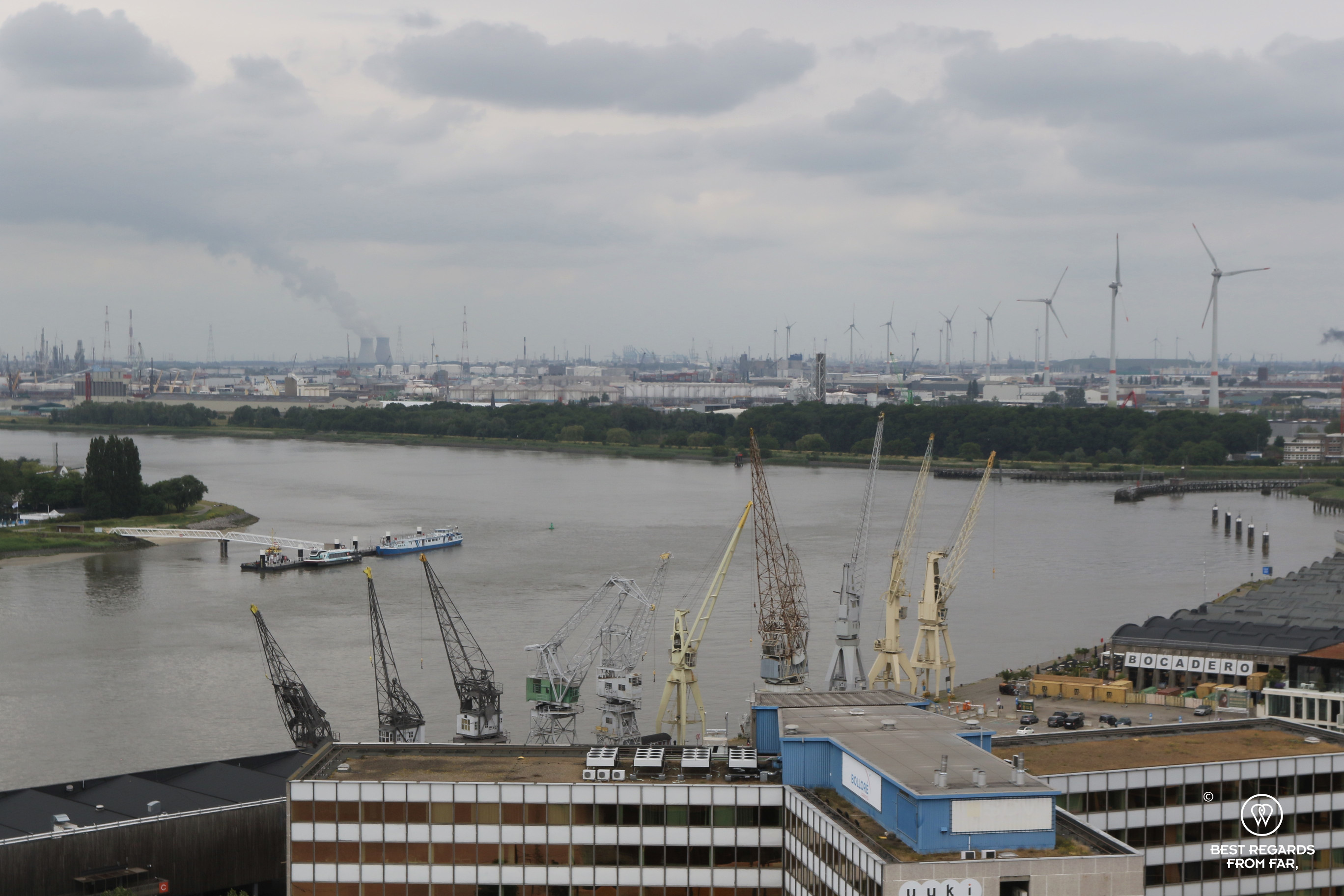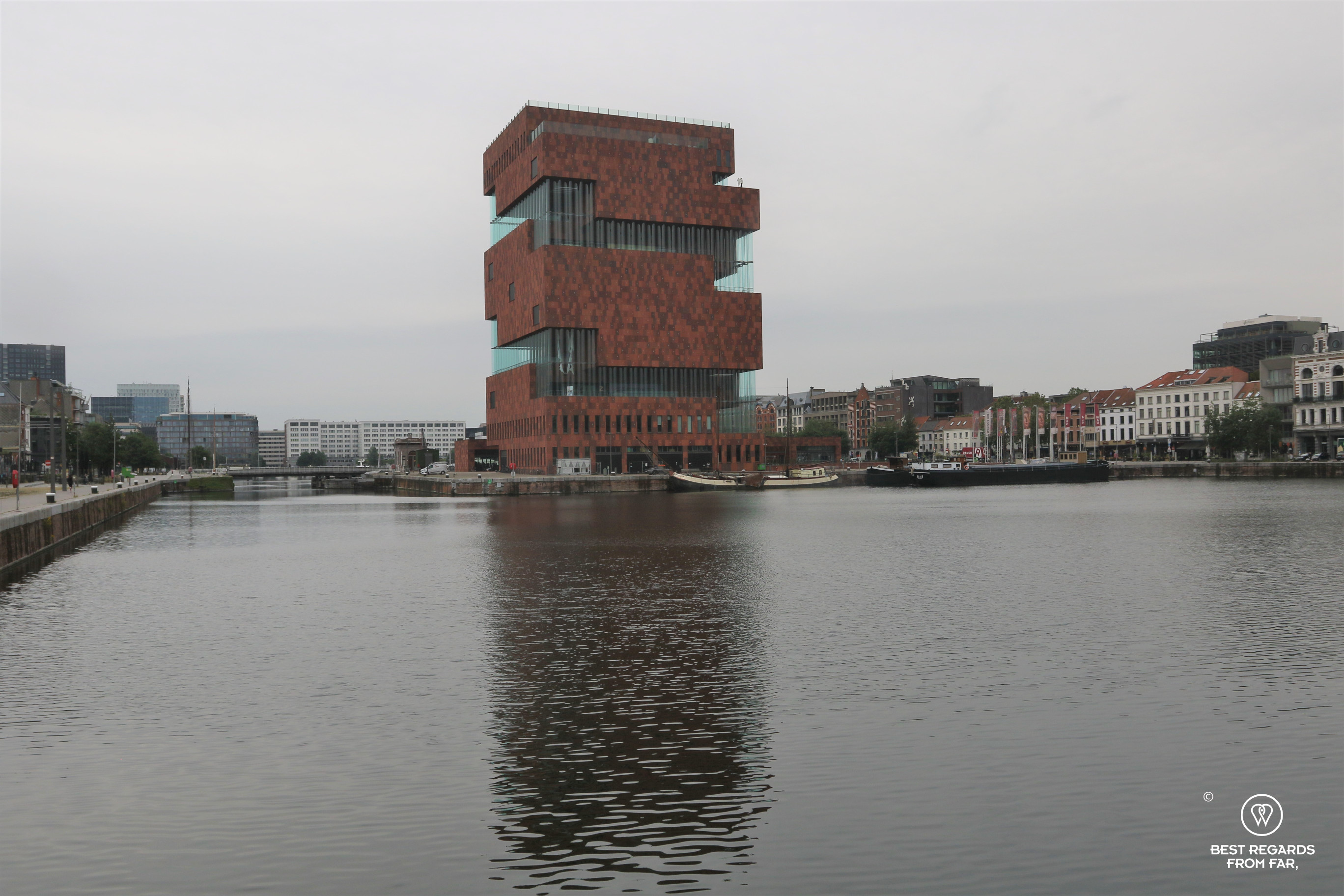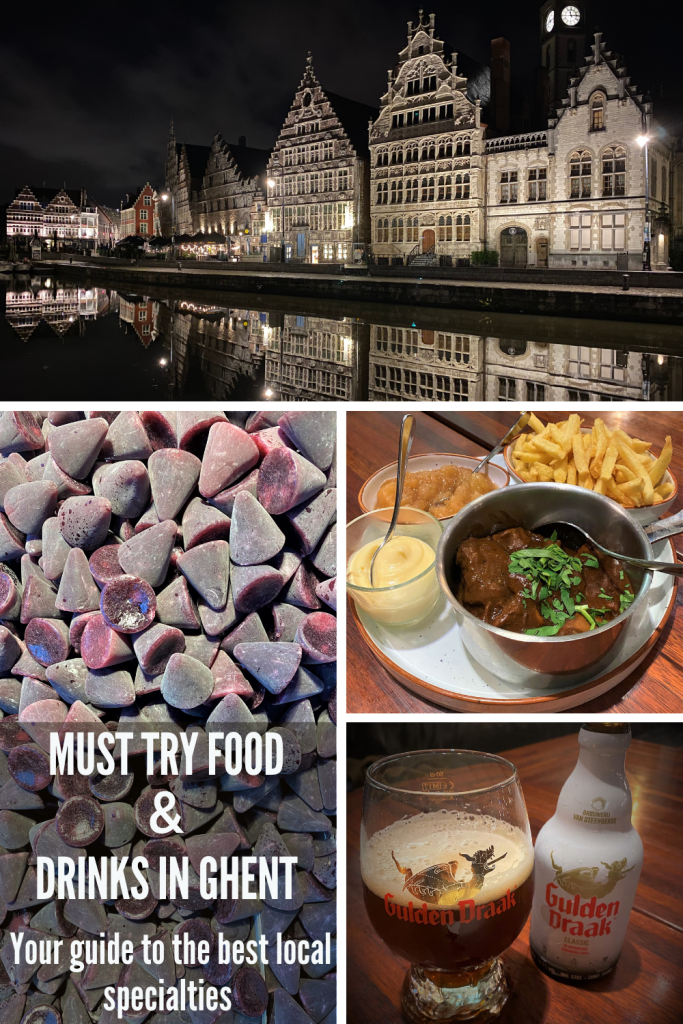Text: Claire Lessiau
Photographs: Claire Lessiau & Marcella van Alphen
The harbour of Antwerp is larger than Antwerp itself… Historically, it allowed the city to become one of the most prominent in the world during its Golden Age in the 15th and 16th centuries. Today, it provides 150,000 jobs, greatly contributes to the wealth of the region of Flanders and propels Antwerp as the second city of Belgium. Hop on a bike to discover Europe’s second largest harbour (after Rotterdam), between capsize bulk carriers and cute villages surrounded by nature.
Pin it or bookmark it for later!
From the heart of Antwerp, where the harbour used to sprout in front of the medieval fortress of Het Steen, it is only a short bicycle ride to reach today’s industrial harbour. Along the way, former open warehouses line the shore of the Scheldt River, all the way to the Bonaparte Dock, the oldest dock designed by the French emperor Napoleon in 1811. Today, the museum dock is the foreground for the MAS (Museum Aan de Stroom) that has become an iconic building in the city. From the rooftop of this red sandstone modern tower, a reminder of the historical brick warehouses of Antwerp, the view on the city and its harbour are unobstructed. Wind turbines, oil refineries and the cooling towers of the Doel nuclear power plant compose the manufactured landscape of today’s docks, sprawling all the way to the Dutch border, about 20 kilometres North West of Antwerp.



Throughout the hip Het Eilandje (Little Island) neighbourhood, past trendy restaurants and cool bars, a few other iconic buildings are scattered along the way to the industrial harbour.
The Red Star Line Museum pays tribute to migrants, and more specifically, to the more than two million of them from Eastern Europe, who left via Antwerp for the Americas on the Red Star steamers between 1873 and 1934 from this very building. It follows in the footsteps of these Belgium people from Flanders for whom the lack of industry in the region added up to the agricultural crisis of the 1880’s and the population boom. In the countryside, where new factories in cities in Wallonia or France made traditional rural home industries redundant, inhabitants often slept in worm-infested straw beds, not being able to build a fire to warm up, with a cold and humid wind penetrating the living space where kids worked late into the night to help their parents make ends meet. These people either fled for industrial towns, or hearing promising news from overseas, decided to leave everything behind to cross the ocean to find a job and settle in Northern America where the economy was thriving, until the Great Depression of the 1930’s that halted immigration.





Many of these migrants would end up by the Red Star Line terminal. The shipping company set up in 1873 used to cargo goods from the USA and passengers on the 10-day return journey. For Belgium people, reaching Antwerp was rather easy. For Eastern Europeans, it was already a long journey, most often by train, in uncomfortable conditions, thankfully ending at the beautiful Central Station in the Diamond District.



Today’s Red Star Line building was an important step for them: passengers and their luggage had to be disinfected in order to be able to immigrate to the New World. If the Red Star Line doctors failed to notice a health condition, the American authorities would refuse the migrant, who would be sent back to Europe at the expense of the Red Star Line. The first-class voyage was luxurious and enjoyed by the wealthy or famous such as Albert Einstein. The third-class passage was not so pleasant, but for many, this was the ticket to a new life, once deemed fit for work by the USA, often in Ellis Island in New York City.
After this thorough check, many travellers would flock the bustling shopping streets of Antwerp, probably passing by the nearby café of the van Mieghem’s. Eugeen, the son, was fascinated by life on the waterfront. Drawing on everything he could find, he would depict the hardship of migrants, refugees and dock workers with a very sharp sense of observation painting very realistic harbour scenes from those times. Eugeen van Mieghem (1875-1930) became a renowned artist, teaching at the Academy of Antwerp and a member of the Antwerp intelligentsia. He also painted the bourgeoisie of Antwerp and their lavish parties in the city centre, but his heart and art had always remained close to the Red Star Line terminal, in the harbour of Antwerp where he was raised.


A bit further along the Scheldt River, the Port House (Havenhuis Antwerp), is an architectural masterpiece! Designed by Zaha Hadid Architects, the headquarters of the Antwerp Port Authority consists of the former fire station, designed as a typical Hanseatic house, and an upper volume made of a diamond-shaped glass façade. From there, the second largest harbour of Europe by total freight shipped is run.



Slightly past the Port House, different biking options reveal the behind-the-scenes of the everyday needs of our modern lives. One option is to bike all the way to the Fort of Lillo about 18 kilometres from the city centre (hence a 36-kilometre (22-mile) roundtrip). Another one is to go for a shorter 14-kilometre (9-mile) loop around the docks. For the bravest, combining both by going all around the harbour to the Dutch border makes for a 60-kilometre (37-mile) loop. Note that water buses run on the river, allowing for a shortcut.



When opting for the first option, The Noordkasteel Park with its view on the skyline of Antwerp is surprisingly quiet and green. The bike path continues along the Scheldt River, lined with oil refineries and petrochemical plants. Street art adds colour to the crude oil tanks, furnaces, heat exchangers, steam crackers, distillation towers and control rooms of the refineries. Surprisingly, along the bank of the estuary, rabbits, pheasants and geese run in the grass.




Around Lillo Fort, a tiny part of Lillo village remains. Most of it was destroyed to make room for the harbour installations, and about 50 inhabitants still live in the miniature village with its brick houses, café and unexpected yacht club. Completely surrounded by the harbour, the village with its old gunpowder storage and church, colourful flowers lighting up the façades of its small brick houses and the playground feels surreal. To take it in, there is nothing better than enjoying a local beer at the café. If the oldest brewery in Antwerp, de Koninck, is now part of the Duvel Moortgat Brewery, it remains a local’s favourite with its smooth De Koninck in its chalice glass (if you want to sound like a local, ask for “het bolleke”) or its full-flavoured Triple d’Anvers.




Massive trucks pass by regularly along the smaller loop around the inner part of the harbour. Compared to the industrial installations and containers, they look like small toys. Biking on the bridges across the docks shows how connected the Estuary of the Scheldt River is to rail, road, canal and river waterways to all of Europe. A few men on electric bicycles rush to or out of work in their bright orange or yellow safety jackets on the well-maintained cycle paths.







Some of these men gather at the frying shack at the entrance of the harbour after work. Fries, snacks and beer cans pile up on simple wooden picnic tables while lively discussions break the humming sound of the surrounding industrial facilities. This gives a more human side to this gigantic harbour: despite as many as 150,000 workers, they can hardly be seen amidst the titanic infrastructures. Beyond the industrial side of its port, Antwerp remains a very human city, home to 170 nationalities. Some call it home, many travellers are passing through with hopes and fears, faced with the uncertainty of the unknown in search for a better life, in a similar way the Red Star Line passengers felt a hundred years ago.
Travel tips:
- The van Mieghem Museum showcases artwork by the Flemish artist and is an excellent way to better apprehend life at the harbour about a hundred years ago, and to enjoy his touching paintings and sketches.
- De Koninck Brewery offers a very interesting brewery tour, full of Belgium humour and comes highly recommended, even if it is slightly out of town. It is still easily accessible by tram or bike from the city centre.
- The Red Star Line Museum is simply excellent, and has never been that actual. A must-visit in Antwerp!
- The MAS is also a museum, even if its main highlight remains its iconic architecture and rooftop terrace.
- To ease your trip, Visit Antwerp sells an Antwerp City Card that includes all of the attractions described in this article, as well as public transport.
- For a great location and comfortable stay, the 4-star Hotel Rubens Grote Markt is ideal to explore Antwerp!
- Check out this interactive map for the specific details to help you plan your trip and more articles and photos (zoom out) about the area (short tutorial to also download your biking GPS track)!
For more highlights of Antwerp & Belgium, click on the images below:






